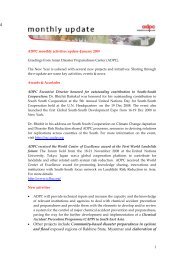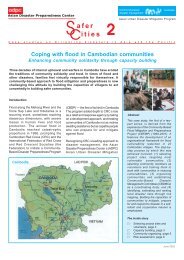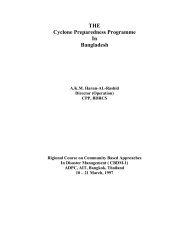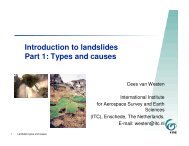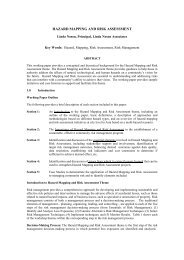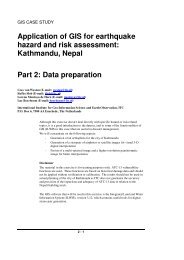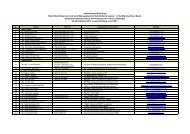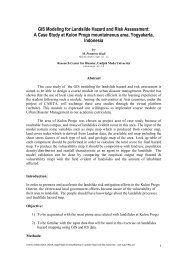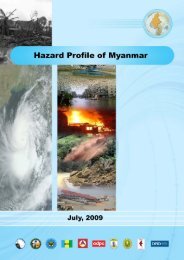community-based disaster risk management and the media media kit
community-based disaster risk management and the media media kit
community-based disaster risk management and the media media kit
Create successful ePaper yourself
Turn your PDF publications into a flip-book with our unique Google optimized e-Paper software.
Flood Survival Tips<br />
chapter 3. useful information for <strong>the</strong> <strong>media</strong><br />
If you are living in an area prone to fl oods, following this advice can<br />
save your life <strong>and</strong> property.<br />
Before <strong>the</strong> Flood<br />
Flood preparedness<br />
• Ensure that all communities <strong>and</strong> family members living in fl ood<br />
prone areas underst<strong>and</strong> <strong>the</strong> dangers properly.<br />
• Know <strong>the</strong> fl ood history of your area.<br />
• Make a mental note of where <strong>the</strong> high ground is.<br />
• Underst<strong>and</strong> <strong>the</strong> fl ood warning messages, what will be <strong>the</strong> impacts of<br />
major, moderate <strong>and</strong> minor fl ooding to your area, <strong>and</strong> what are <strong>the</strong><br />
areas vulnerable to different degrees of fl ooding.<br />
• In times of adverse wea<strong>the</strong>r conditions, always listen to <strong>the</strong> offi cial<br />
warnings issued by local authorities <strong>and</strong> news reports on <strong>the</strong> local<br />
radio or television.<br />
• Prepare a fl ood emergency <strong>kit</strong>.<br />
• Prepare <strong>and</strong> discuss <strong>the</strong> details of local fl ood hazard map with <strong>the</strong><br />
involvement of o<strong>the</strong>r <strong>community</strong> members.<br />
• Indicate <strong>the</strong> fl ood path <strong>and</strong> possible sequences of fl ooding in <strong>the</strong><br />
area in advance.<br />
• Evacuation plans should be made in advance. Each member of<br />
<strong>the</strong> family must be given specifi c instructions <strong>and</strong> responsibilities in<br />
case of evacuation.<br />
• If your <strong>community</strong> has boats, make sure that <strong>the</strong>y are well maintained<br />
<strong>and</strong> properly tied up to a tree or o<strong>the</strong>r permanent object.<br />
• Protect <strong>community</strong> water supply sources.<br />
• Inspect escape routes, houses, etc. before fl oods for weaknesses. If<br />
you fi nd any, help to protect <strong>the</strong>m by building up a wall of s<strong>and</strong> bags<br />
to block <strong>the</strong> fl ood waters.<br />
• If communities are subject to fl ash fl oods, organize groups <strong>and</strong><br />
plan for fl ood level monitoring <strong>and</strong> have a discussion on how <strong>the</strong><br />
information can be disseminated.<br />
• Organize a search <strong>and</strong> rescue (S&R) team <strong>and</strong> identify <strong>the</strong> areas<br />
which will be isolated in case of fl ooding. Prepare a plan for <strong>the</strong> S&R<br />
team.<br />
• Organize a fi rst aid team <strong>and</strong> ensure it has proper fi rst aid equipment<br />
<strong>and</strong> emergency medicine <strong>kit</strong>.<br />
43



